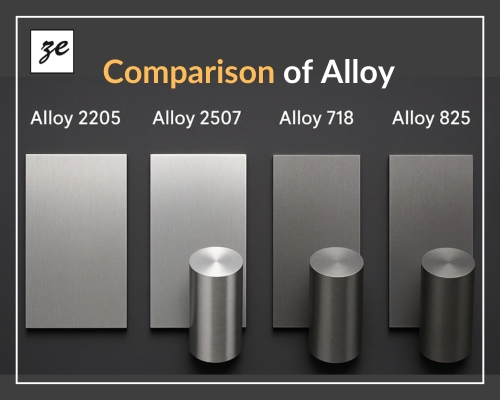Comparison of Alloy 2205, 2507, 718, 825
When it comes to industrial applications, choosing the right alloy is a critical decision that impacts performance, durability, and cost-effectiveness. Different industries such as oil & gas, chemical processing, marine engineering, and aerospace demand materials that can withstand extreme temperatures, corrosive environments, and heavy loads. Four of the most widely used high-performance alloys are Alloy 2205, 2507, 718, and 825. Each has its own unique composition, properties, and application areas.
Understanding the Basics
• Alloy 2205: A duplex stainless steel with high strength and excellent resistance to stress corrosion cracking.
• Alloy 2507: A super duplex stainless steel with superior resistance to pitting and crevice corrosion.
• Alloy 718: A nickel-based superalloy designed for extreme temperature resistance, often used in aerospace and power generation.
• Alloy 825: A nickel-iron-chromium alloy with excellent resistance to acid attacks, ideal for chemical and marine industries.
Alloy 2205: The Duplex Performer
Alloy 2205 is one of the most widely used duplex stainless steels. Its structure contains both austenitic and ferritic phases, giving it a unique balance of strength and corrosion resistance.
Use Cases:
• Oil & gas pipelines
• Pressure vessels
• Marine applications
• Heat exchangers
Performance Insight:
Compared to standard stainless steels, Alloy 2205 provides better strength while reducing material thickness, making it cost-efficient. However, it is not suitable for very high temperatures, which limits its use in aerospace or power turbine environments.
Alloy 2507: The Super Duplex Champion
If Alloy 2205 is strong, Alloy 2507 takes it a step further. Known as a super duplex stainless steel, it is designed for highly corrosive conditions, especially those involving seawater and aggressive chemicals.
Use Cases:
• Offshore platforms
• Desalination plants
• Chemical processing equipment
• Pulp and paper industry
Performance Insight:
Alloy 2507 is often chosen over Alloy 2205 when applications demand superior corrosion resistance, especially in seawater environments. While costlier than Alloy 2205, it offers a longer lifespan in aggressive service conditions, reducing maintenance costs.
Alloy 718: The Nickel-Based Superalloy
Unlike duplex stainless steels, Alloy 718 is a nickel-chromium superalloy engineered for extreme environments. It retains high strength and oxidation resistance even at elevated temperatures.
Use Cases:
• Jet engines and gas turbines
• Power generation equipment
• Nuclear reactors
• High-performance fasteners and springs
Alloy 825: The Corrosion Specialist
Alloy 825 is primarily chosen for its outstanding resistance to acids such as sulfuric, phosphoric, and nitric acid. This makes it an excellent choice for industries where chemical exposure is frequent.
Use Cases:
• Chemical processing plants
• Acid production equipment
• Marine environments
• Pollution control equipment
Performance Insight:
While not as strong at high temperatures as Alloy 718, Alloy 825 outperforms many stainless steels and duplex grades in acid resistance. It is a cost-effective solution for industries where chemical exposure is the main concern rather than extreme mechanical loads.
Comparison
| Property / Alloy | Alloy 2205 | Alloy 2507 | Alloy 718 | Alloy 825 |
|---|---|---|---|---|
| Type | Duplex Stainless Steel | Super Duplex Stainless Steel | Nickel-Based Superalloy | Nickel-Iron-Chromium Alloy |
| Strength | High | Very High | Extremely High | Moderate |
| Corrosion Resistance | Excellent | Superior | Good | Excellent in acids |
| Temperature Resistance | Up to 300°C | Up to 250°C | Up to 700°C | Moderate |
| Best Applications | Oil & gas, marine | Offshore, desalination | Aerospace, turbines | Chemical plants, marine |
Choosing the Right Alloy
The choice between Alloy 2205, 2507, 718, and 825 depends on the specific needs of your project:
Use Cases:
• If you need a balance of strength and corrosion resistance at a reasonable cost, Alloy 2205 is a practical choice.
• For extreme corrosion resistance in seawater and harsh chemical environments, Alloy 2507 is superior.
• When high strength and heat resistance are critical, especially in aerospace or power generation, Alloy 718 stands out.
• For chemical processing with high acid exposure, Alloy 825 delivers long-lasting protection.
Final Thoughts
Selecting the right material is not just about cost but about long-term performance, safety, and reliability. Each of these alloys — Alloy 2205, 2507, 718, and 825 — has been engineered to solve specific industrial challenges. By understanding their properties and applications, industries can make informed choices that enhance efficiency and reduce maintenance costs.
At Zeon Exports, we provide high-quality alloys tailored to diverse industries worldwide. Whether your requirement is Alloy 2205, 2507, 718, or 825, we ensure reliable supply, technical support, and the right material for your project.
Frequently Asked Questions (FAQ)
Q1. What is the difference between 2205 and 2507 alloys?
2205 is a duplex stainless steel with good strength and corrosion resistance. 2507 is a super duplex stainless steel with higher strength and much better resistance to seawater and harsh chemicals.
Q2. What is equivalent to 2507 stainless steel?
2507 is also known as UNS S32750, EN 1.4410, or F53 stainless steel. All of these are the same type of super duplex stainless steel.
Q3. What is the difference between 2205 and 2207?
There is no grade called 2207. People often confuse it with 2507. The real difference is that 2205 is duplex, while 2507 (sometimes called 2207 by mistake) is super duplex.
Q4. What is a 2507 steel grade?
2507 is a super duplex stainless steel (UNS S32750) with very high strength and excellent resistance to corrosion, especially in seawater and chemical industries.
Q5. What is the temperature limit of 2205 and 2507?
2205 can handle up to about 300°C, while 2507 is safe up to around 250°C. For higher temperatures, alloys like 718 are used.


